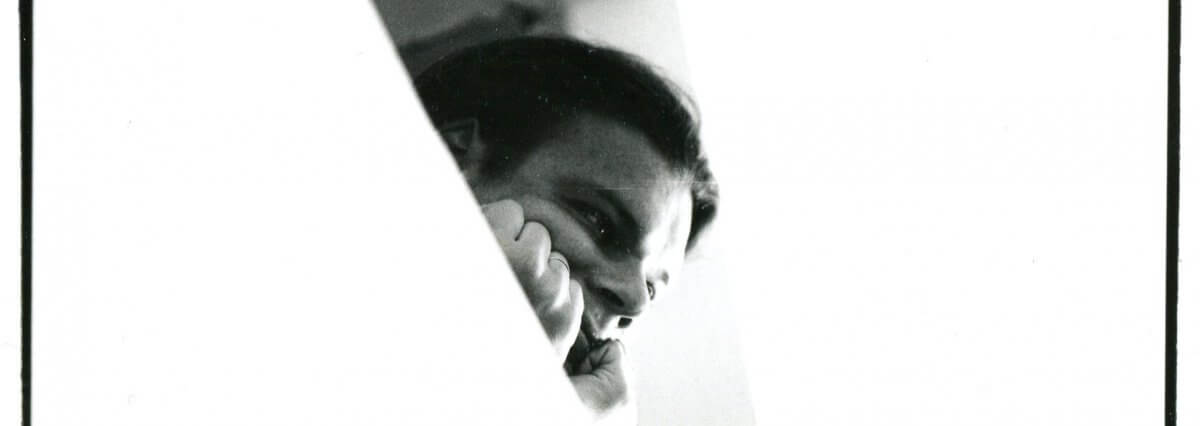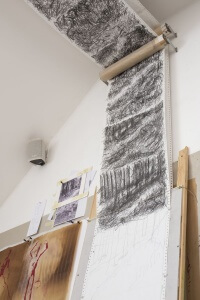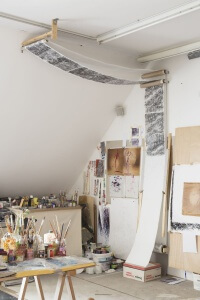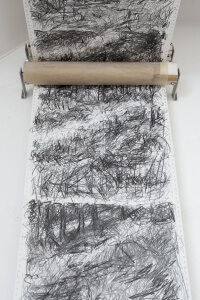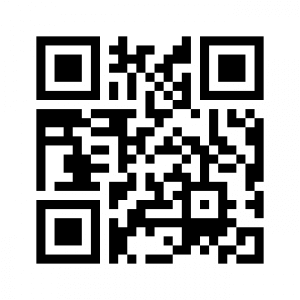The “Drawing Machine“ or About the relations of art and technology
Human’s longing for machines – from the ancient Greeks to this day – a subject increasingly determining Western thinking. Leading to technology and science it predefined the concept of art (via negationis) and the role of the artist as a counter model to technical creation and pure rational being. With the idea of art as irrational, godlike creation and by transferring the concept of god to humans in the early modern times, artists were qualified per definition to create out of nothing. This way the term ‚genius’ became popular as highest maxim of human existence, but as well its counter part, the interpretation of humans as machines “L’Homme Machine” (La Mettrie, 1748).
Formative for our contemporary self-image – despite the opposed wish for creative freedom and autonomy – is the wish of becoming a machine: to be self-regulated and controlled in action, delivering results in a predictable and efficient manner. This seems especially far-fetched with regards to the artistic process, as inventive working is not calculable and accessible, but favour of the moment caused by a mysterious source (formerly: muse’s kiss, since modern times: the genius of the artist).
The current work of the artist Rolf-Maria Krückels is called “Drawing Machine”; with a classic “machine”, related to the first description by Aristotle (340 v. Chr.), it has ropes and rods, roles and leverage in common. The term, taken from the ancient Greek language, literally means “tool for a mechanical working device”.
Such was built by the artist for drawing: Exactly 10,000 sheets continuous paper with perforated margins are pulled upwards from the ground through a paper-transport-mechanism with ropes as tow tractors. This way the sheets are processed one by one on facial height. Once a drawing is finished, it is further rotated upwards, so the next blank sheet stands ready for editing. The finished drawings move up to the ceiling, will pass along transportation rolls and end up behind the drawing panel in a large roll that ultimately will include all 10,000 drawings.
The actual work is the “Drawing Machine” throughout the process, designed as an experiment for questioning the qualitative leap: Is it possible due to a mechanical routine to reach a “genius” level of drawing? Can a completely new level of quality be achieved due to recurrent exercise with devotion within the same conditions? However, the “Drawing Machine” does not contain an automated drive element, only a human one. The artist makes himself a complex component of the machine, he operates it depending on working time and drawing rhythm.
He works almost daily and usually creates four to five drawings per day. The self-imposed task is to draw “the magic number of 10,000” sheets, to achieve a certain exercise quantity. In “Genius Explained” (2001) Michael Howe points out, that this seems to be a necessary precondition for any and all championship and quality extending into the area of genius and exceptional performance. Figuring out whether this empirically investigated reference level of 10,000 units exercise, is not only a necessary but also a sufficient condition for the genius status of the artist and the qualitative size of his work, is the aim of this art work as an self-experiment.
Fascinated by scientific studies on the development of “the genius” and the origin of exceptional phenomena in art and technology, Krückels invented the “Drawing Machine” to work in his favourite medium and to figure out, whether and in which capacity he himself would become a “genius” of drawing at the end of the path.
Rolf-Maria is free in his choice of subject, but focuses on photographs of forests and coverts as references: Close-up views of the woods in the Eifel, places of his childhood and early memories. As child he roamed through the forest, looking for clearings and special places. This way he trained his vision and perception of shapes, outlines and edges – exercising the cognitive and receptive work of the draughtsman for many hours (possibly almost 10.000?). But to express the findings craftsmanship is needed. To realize and transform the insight in all its multitude and concision, a language must be developed.
To find a language of his own is aim and measure of success in this process of re-writing in the medium of drafted painting which marks Krückels style as an artist. Inscribing into the scroll of time may be the underlying motif besides the declared interest in experimental “genius” research. He not only operates the machine, but becomes a part of the mechanical apparatus. Here we find on a formal level, what Krückels already showed us in earlier works (a.e. “I am Dürer” or “I am Seneca”, 2010). His preference for transparent base material, which is here given in a wider sense of the word, as well as the involvement of the artist with his own body and the play of movement as essential part of the drawing process.
Insofar he stresses the importance of reenactment in the artistic process instead of representation. His interest does not lie in envisioning insights of the past via relicts, residues or traces, but instead he uses performative repetition to enable the experience of bygone events on a bodily level. In the course of this process he accomplishes to cancel the concept of identity in an artistic manner in favour of a sensual mediated understanding of the game structure of being. Therefore life itself and any type of process is play – not only in a metaphoric sense, but in conduct – a play defined by dispute and counter-play of opposites. Already Heraclitus (c. 500 BC) defined antagonism (polemos) as origin of all things: “What opposes unites, and the finest attunement stems from things bearing in opposite directions, and all things come about by strife.” (Heraclitus, “About Nature”, fragment 8)
Precisely this fundamental and all qualitative becoming substantiating dichotomy is center and matter of investigation which sustaines Krückels’ ouvre. From his beginings to the “Drawing Machine” today, he is moved by the question of how mind and nature, chance and necessity, complexity and simplicity go together. More concrete: how organic growth and evolution on the one hand and mechanical routine and predictability on the other hand play together as reliably as volatile – and how order arises out of chaos.
These ambivalent aspects of nature and science, which time-compressed express themselves in art and especially in artistic creation, can be studied paradigmatically in the interaction between man and machine. This is served by the “Drawing Machine” – an artistic experiment, which is stimulated by scientific theories of cognitive science and philosophical ideas such as the “genius concept” of modern times or the “Daimonion” term of the Greek’s ancient world, whose validity and precisely extent is inquired – by providing a new contemporary language for questioning the relations between art and technology.
Dr. Karin Hutflötz, August 2015
Email to RMK:
